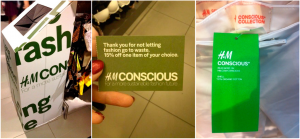 It is interesting to start noticing the updated lens in which I now view my everyday consumption of products and services due to my participation in the ‘Sustainability Marketing’ course this term. Yesterday evening, I had gone into H&M and noticed a large graphic advertising one of the company’s sustainability initiatives. The graphic depicted H&M’s platform that provides consumers the ability to return clothes that they no longer plan on using.
It is interesting to start noticing the updated lens in which I now view my everyday consumption of products and services due to my participation in the ‘Sustainability Marketing’ course this term. Yesterday evening, I had gone into H&M and noticed a large graphic advertising one of the company’s sustainability initiatives. The graphic depicted H&M’s platform that provides consumers the ability to return clothes that they no longer plan on using.
Perplexed by this given my understanding that H&M adheres to the practices of “fast fashion”, I immediately went home and looked into this sustainability initiative. The website writes, “as much as 95% of clothes thrown away could have been re-worn or recycled”. Their website also links to the company’s “Sustainability Commitment” it makes with all business partners, composed of the following three sections: “Healthy Workplaces”, “Healthy Ecosystems”, and “Animal Warfare”. The first section focuses largely on the company adhering to basic labor laws. The second touches on environmental sustainability by committing to initiatives like “reduc[ing] water usage”, although fails to identify any particular targets or deadlines. The third section also focuses on the company complying with basic animal regulations.
I then googled the terms “H&M” and “Sustainability” together, only to come across quotes by representatives of the company essentially discrediting this particular recycling initiative. It was made clear that a lot of the blended fabrics the company uses cannot be separated and reused, as well as the fact that they do not recycle cottons due to concerns about decreasing the quality of the resulting fabrics. While not surprising, this was quite disappointing to come across. Everything that I had learned over this term regarding ‘greenwashing’ was so evidently exemplified by this company that had been a frequent consumer of.
I began to reflect on why it is that I was as affected as I was to actually confirm my previous preconceptions about the company’s greenwashing. It ultimately came down to transparency, and trust more largely, that influences how we feel about different businesses. As humans, the products and services we consume are reflective of our values as people, which then go on to influence and shape our own self-identities. If a company is insincere, the consumer inevitably ponders what that means about our own selves. A question often gets raised surrounding whether greenwashing is better than doing nothing at all. In cases like this, I would prefer to consume from companies that were truthful in what sustainable practices they do or do not adhere to.
Link: http://about.hm.com/en/sustainability.html
NezikaMulyadi
February 28, 2017 — 2:06 pm
Hi Hussam! Thank you for the informative and a very eye-opening post. I myself are aware how these unsustainable practices are deeply engrained in the infrastructure and consumption habits. H&M provides affordable clothing that adheres to somehow style conscious individuals that want to keep up with trends. I find that our material-seeking culture, which affects our consumptive behaviour is also a prominent factor that supports businesses like H&M to thrive. This is hard as behaviour is a deeply rooted element that is hard to change. In addition, the concern regarding affordability is also a significant factor in preventing more sustainable purchases.
While it’s definitely the first step for use to raise awareness regarding green washing practices like what H&M is currently doing and encourage consumers to be more vigilant, I always hit a brick wall when thinking of alternatives and more effective ways on how to reach consumers that will bypass their consumption behaviour and need for affordability. Other than changing the traditional business model that we learned in class which would take a long transition time, I want to know your thoughts regarding any fast-result solutions that still have some possible long term benefits that companies can do! Any ideas?
Thank you again for your post! I really enjoyed it!